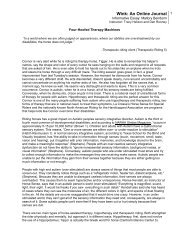The History of Western Technical College
The History of Western Technical College
The History of Western Technical College
Create successful ePaper yourself
Turn your PDF publications into a flip-book with our unique Google optimized e-Paper software.
It is fairly evident that the present depression has caused many people to do more thinking about the job future. Many<br />
young people are looking the situation squarely in the face. <strong>The</strong>y see the necessity for being prepared to do something<br />
rather than to just be ready to do anything."<br />
A Homecraft program was begun - <strong>The</strong> craft programs began at the Oak Forest Sanatorium in 1931. Homecraft consisted<br />
<strong>of</strong> training in the type <strong>of</strong> craft the trainee is interested in and capable <strong>of</strong> doing. <strong>The</strong> crafts taught included woodcrafts,<br />
metal crafts, hand and loom weaving, ceramics, silkscreen printing, leather craft, machine sewing, needlecraft and some<br />
decorative assembly work. An instructor provided instruction in the home on an average <strong>of</strong> once every two weeks, with<br />
program trainees progressing at their own speed. No tuition was charged for this training as the Rehabilitation Division <strong>of</strong><br />
the State Board <strong>of</strong> Vocational and Adult Education paid for the cost. <strong>The</strong> severely handicapped in La Crosse, Vernon,<br />
Monroe and the western part <strong>of</strong> Juneau County were eligible. <strong>The</strong> oldest and best develop program <strong>of</strong> occupational<br />
therapy at a La Crosse County Hospital was that carried on for many years at the Oak Forest Sanatorium in Onalaska,<br />
where the groundwork was laid in 1931. A Miss Cynthia Herbert, who worked afternoons twice a week, conducted<br />
classes for a year. <strong>The</strong> work was supervised and paid for by the La Crosse Vocational and Adult Schools.<br />
In addition to the variety <strong>of</strong> annual Evening School exhibits, the Spring 1931 Open House also displayed items made by<br />
the patients <strong>of</strong> the Oak Forest Sanatorium in their homecraft activities.<br />
In 1931, in the commercial department <strong>of</strong> the school, 115 persons were enrolled with the typewriting class having 30<br />
students. <strong>The</strong>re were 85 teachers instructing night school. Classes in occupational therapy were conducted at the (Oak<br />
Forest) sanitarium (Onalaska), classes for nurses at the hospital, and other classes at various industrial plants. A new rifle<br />
club activity, sponsored by the American Legion Rifle Club, was started in 1931, and a shooting range was established.<br />
In 1932, the Vocational School in cooperation with the American Red Cross <strong>of</strong>fered a course in home Hygiene and Care <strong>of</strong><br />
the Sick.<br />
<strong>The</strong> 1932 Vocational School art display attracted much interest—oil paintings, water colors, pencil and pen sketches—all<br />
revealed the talent <strong>of</strong> local artistry. It was estimated that approximately 3,000 people saw the Evening School exhibits. It<br />
was lauded as a "most praiseworthy" exhibition <strong>of</strong> art and craft.<br />
March 15, 1932, the Vocational Dramatic Guild marked its beginning .. . <strong>The</strong> Guild was conducted on a nonpr<strong>of</strong>it basis,<br />
with all receipts from the productions utilized in the maintenance <strong>of</strong> the department <strong>of</strong> Dramatic Art. "<strong>The</strong> Vocational<br />
School, recognizing the value <strong>of</strong> dramatic activity, has thrown open to the Guild all the fine facilities <strong>of</strong> its various<br />
departments." March 15, 1932 was the first meeting <strong>of</strong> those interested in dramatic development with classes planned<br />
for beginning and advanced students. This move placed the Vocational School far in advance <strong>of</strong> many colleges, and gave<br />
it further claim to widespread recognition throughout the United States. Everyone has creative urges and there is no<br />
place where they can be so easily manifested as in dramatics.<br />
"<strong>The</strong> Cradle Song," chosen for the first public performance by the classes in Dramatic Art at the Vocational School was<br />
presented on November 27-28, 1933 in the Vocational School Auditorium. "<strong>The</strong> Cradle Song" a comedy in two acts with<br />
an interlude in verse, had a cast <strong>of</strong> ten women and four men and was directed by Russell Huber (Huber, a well-known<br />
personality in the La Crosse area, worked with both WIZM radio and WKBT television and interviewed many stars <strong>of</strong><br />
drama and the theater world.) "You certainly are to be complimented on that wonderful play ... it was a real treat for all<br />
who saw it. I could not help but marvel how perfectly it was carried out in every detail. Director and players must have<br />
credit where credit is due—it was beyond expectation," wrote one who attended the play.<br />
In January 1934, the La Crosse Vocational School sponsored the Emergency Educational Program (EEP) under which 25<br />
unemployed teachers were put to work. <strong>The</strong> primary objective <strong>of</strong> the program was to give work to unemployed teachers.<br />
It was a governmental program, with funding through the State Board <strong>of</strong> Vocational Education in Madison. All salaries <strong>of</strong><br />
teachers were paid directly from federal funds allotted to Wisconsin for this extension <strong>of</strong> its educational activities. Eighty<br />
classes were maintained under the EEP in La Crosse. As the La Crosse State Teachers <strong>College</strong> was regarded as outstanding<br />
in training teachers for physical education work, by the law <strong>of</strong> averages there were more unemployed physical education<br />
teachers anticipated than teachers <strong>of</strong> academic subjects.<br />
April 1934 - Winding up a season whose success might almost be called sensational, the Vocational Dramatic Guild put on<br />
Oscar Wilde's "Lady Windermere's Fan" as its closing production.

















